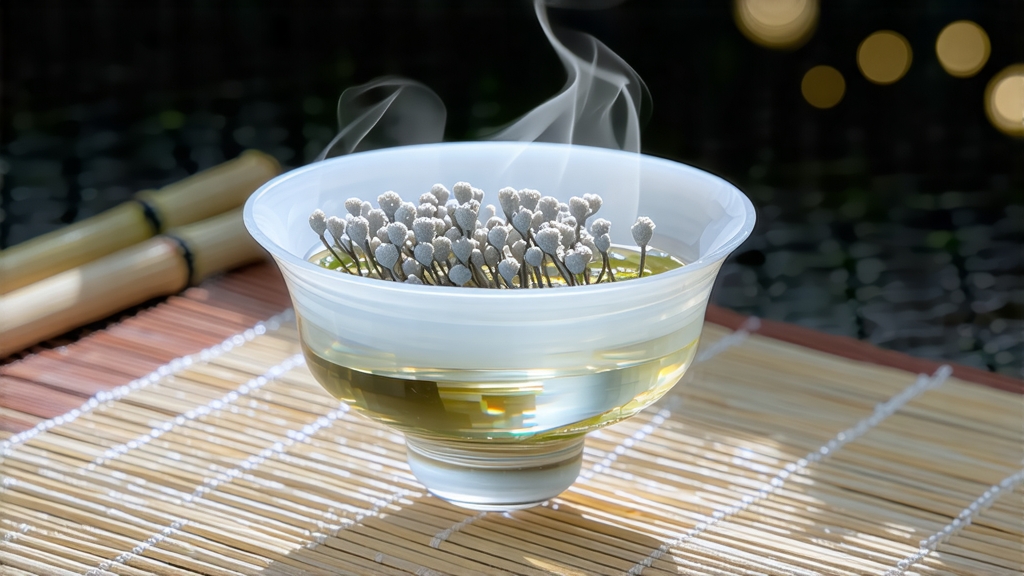
Among the six great families of Chinese tea, white tea is the least theatrical yet the most elusive. It is picked, withered, and dried—nothing more—but in that seeming passivity lies a mastery of time, air, and light. Within this minimalist spectrum, Bai Hao Yin Zhen—literally “White-Hair Silver Needle”—stands as the purest expression: only unopened buds, silvered by trichomes, plucked for a few spring mornings each year. To understand China’s white-tea tradition, one must begin with this single-bud tea, whose history, craft, and flavor carry the quiet grandeur of moonlight on a calm lake.
Historical whispers
Silver Needle’s documented story starts in the 1790s, when the ruling Qing court still demanded tribute tea from Fujian’s northern coast. Local chronicles from Fuding county record that, instead of roasting the buds as was customary for green tribute tea, growers simply sun-dried them on reed trays. The pale infusion and naturally sweet aroma so delighted the imperial taster that the technique was codified as “white tea.” By the late nineteenth century, Silver Needle was being compressed into small cakes, shipped down the Min River to Fuzhou, then exported through Hong Kong to Southeast Asia and Europe, where it acquired the poetic moniker “China White.” While black and oolong teas dominated the maritime trade, Silver Needle remained a connoisseur’s whisper, prized for its medicinal reputation—cooling the body, soothing the throat, and, as modern biochemistry now confirms, delivering the highest antioxidant load of any Camellia sinensis product.
Terroir and micro-seasons
Authentic Silver Needle comes from two protected origins: Fuding and Zhenghe, both within Fujian’s hilly northeast. Fuding’s terroir is granitic, well-drained, and laced with sea mist; Zhenghe sits slightly higher, with volcanic loam and cooler nights. Each region nurtures a distinct cultivar—Fuding Dabai and Zhenghe Dabai—whose bushes sprout unusually fat buds, 2.5–3 cm long and densely coated with protective hairs. The picking window is brutally short: the first flush of spring, when the bud stands erect but the first leaf has not yet unfurled, usually a span of seven to ten days around the Qingming festival. Experienced pickers can gather barely one kilogram of fresh buds per day; five kilograms of buds yield only one kilogram of finished tea. Thus every sip condenses roughly forty buds, each plucked at dawn while still cool with dew.
Crafting stillness: the withering ritual
Unlike green tea, whose character is fixed by pan-fire, Silver Needle is coaxed into being through a 48- to 60-hour dialogue between leaf, air, and subtle heat. The process is called “two suns and two winds.” Fresh buds are first spread thinly under morning sunlight for twenty minutes—just long enough to evaporate surface moisture without scorching the down. They are then moved indoors onto bamboo racks where ambient wind, generated by horizontal vents in the old factory walls, continues dehydration. Temperature is maintained at 22–26 °C and relative humidity around 65%. Every forty minutes the tea master gently turns the buds with a feather-light touch; too much force will bruise the cells, inviting premature oxidation and the loss of signature freshness. At night the racks are stacked in chambers warmed by charcoal embers buried in ash, a technique that provides steady infrared heat without smoke. By the second afternoon the buds have lost 90% of their weight, curling slightly like sleeping commas, their silver hairs shimmering under lamplight. A final fifteen-minute bake at 40 °C lowers moisture to 5%, ensuring microbiological stability while preserving the enzymes that will allow graceful aging.
Aging: white tea’s hidden dimension
Although often celebrated for its youthful delicacy, Silver Needle is one of the few teas that improve over decades. Enzymes retained during gentle processing continue slow oxidation in the presence of residual oxygen. Stored in breathable paper lined with cotton, then packed into earthenware jars and kept at 25 °C and 50% humidity, the buds darken from platinum to pewter, while the flavor migrates from crisp pear and honeysuckle toward dried apricot, sandalwood, and camphor. A 20-year-old Fuding Silver Needle can fetch prices rivaling vintage pu-erh, its liquor glowing amber and its finish cooling like mint.
Tasting notes: the lexicon